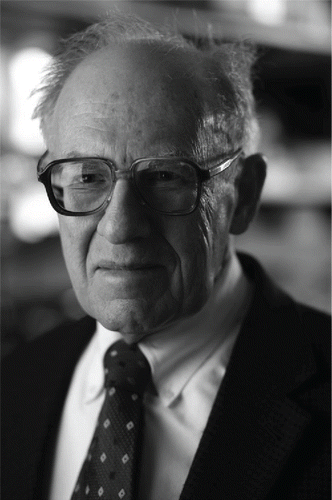Sidney Mirvish, 86, of Omaha, Neb., an outstanding scientist and prominent leader in the field of carcinogenesis, died on August 23. He was a professor emeritus in the Eppley Institute for Research in Cancer and Allied Diseases at the University of Nebraska Medical Center.
A pioneer in the role of vitamin C in nitrite reactions, Dr. Mirvish's research had a significant impact on food safety. Based on his discovery, the U.S. Food and Drug Administration required that increased amounts of vitamin C be added to nitrite-cured meat to lower carcinogenic N-nitroso compound formation and reduce the nitrite levels. From a public health perspective, the supplemental Vitamin C improved the safety of many commonly eaten foods, such as bacon, hot dogs, sausage, and lunch meat, particularly with regard to gastric and possibly colon cancer.
Dr. Mirvish was born March 12, 1929 in Cape Town, South Africa. His grandfather was a rabbi and his father was a physician. He attended college as a premedical student, however, because of his deep interest in the field of chemistry, he later decided to become a chemist. He obtained a B.S. degree in chemistry and physiology (1948), and a M.S. degree in organic chemistry (1950) at the University of Cape Town. Dr. Mirvish was awarded the Jamison Scholarship (1951–1953) to study at the University of Cambridge, England and earned a Ph.D. degree in organic chemistry there in 1955.
After teaching at the University of Witwatersrand in Johannesburg, South Africa (1955–1960), Dr. Mirvish began his research career at the Weizmann Institute of Science in Israel (1961–1969). He received the Eleanor Roosevelt International Fellowship from the American Cancer Society, which allowed him to conduct his research at the McArdle Laboratory of Cancer Research at the University of Wisconsin-Madison (1965–1966). Dr. Mirvish joined the Eppley Institute in 1969. He was recruited as an associate professor and was promoted to full professor in 1972. He served as interim deputy director and associate director of the Eppley Institute from 1981 to 1986. Dr. Mirvish's research focused on metabolic and carcinogenic behavior in specific food, particularly N-nitroso compounds, which includes nitrosamines, to improve cancer prevention and treatment.
His original study of vitamin C and nitrite reaction, which was published in Science 177, 65–68, 1972, provided a method to block the formation of carcinogenic N-nitroso compounds and decrease nitrite levels. Soon afterwards, vitamin C became an essential ingredient of all processed meats.
Dr. Mirvish was a highly productive scientist. His lab was funded by the National Cancer Institute through 2013 (as a professor emeritus at the age of 84). He authored approximately 160 peer review publications. His achievement in carcinogenesis research was internationally recognized. His picture was on the front cover of Cancer Research (September 1989). His Science paper was listed on the Science Citation Classic, Current Contents 30, 19, 1987 and he was a recipient of the Outstanding Research and Creative Activity Award from the University of Nebraska in 1986. In addition, Dr. Mirvish was a member of many NIH review committees: N-nitroso compound formation (1990); comprehensive cancer center core grant (1991); program projects on gastric cancer (1992) and tobacco carcinogenesis (1995); and ad hoc member of National Institute on Drug Abuse review committee in 1994–1995. He served as an Associate Editor of Nutrition and Cancer since 1997.
Through his many accomplishments as a scientist, Dr. Mirvish helped build the scientific reputation of the Eppley Institute and the University of Nebraska Medical Center. Dr. Mirvish was a gentle and unassuming man. His kindness, thoughtful compassion and dedication to research and teaching were at the highest level, which brought him many friends for life. As a teacher, he taught by example, and as a friend, he lived by example.
He was a demanding, but beloved, mentor for students and postdoctoral fellows. He also was a very knowledgeable advisor and collaborator to his colleagues. Dr. Mirvish's characteristics and wisdom could easily be found at seminars or conferences. Backpack at hand, he always sat in the front row and was not afraid to ask questions about any subject. Oftentimes, his questions were the most important and insightful ones asked because they would invariably get to the heart of the issue.
Long after his official retirement, Dr. Mirvish continued to work on publications, review others' papers, discuss his ideas, and write grant applications. His research team recently determined that excretion of urinary N-nitroso compounds was about 60% of fecal N-nitroso compound excretion after NaNO2 was fed to rats. Based on that finding, Dr. Mirvish thought that urinary N-nitroso compound excretion in humans could serve as a biomarker to indicate exposure to N-nitroso compounds in the colon. It was a creative approach to study colon carcinogenesis, and he was writing a grant proposal about this new idea when he passed away. Although he had felt sick for several days, Dr. Mirvish was working on his publication in his office all day on August 18. That same night he was taken to the hospital for an emergency surgery. Unfortunately, it was too late, and he passed away a few days later.
Dr. Mirvish is survived by his loving wife, Lynda, and children, Leora Mirvish and Daniel (Rachel) Mirvish; sister, Doreen Bahiri; and grandchildren, Rebecca, Jonathan, and Miriam. At his graveside service in Omaha's Beth Israel Cemetery on August 25, hundreds of colleagues and friends remembered his legacy to the field and his passion for science. Dr. Mirvish was not only a renowned scientist, but also was a generous, warm human being, and a good friend and colleague. He will be dearly missed.

